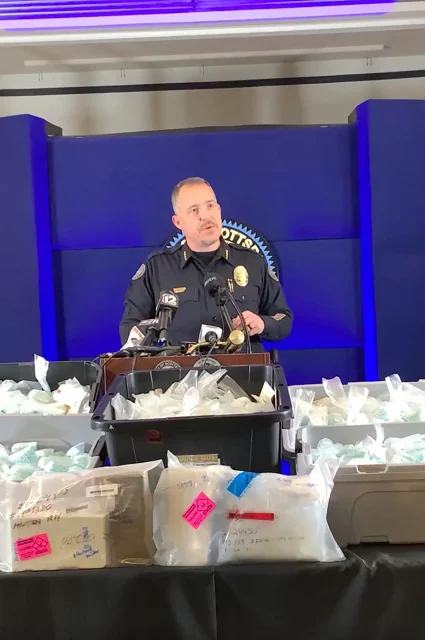Atlanta, GA – Experts from the Centers for Disease Control in Atlanta are warning parents about a new and highly potent form of synthetic sugar that is flooding playgrounds and birthday parties, and even finding its way into home pantries across the United States.

Pittsburgh baby Gary Peterson, shown here developing fentanose-induced excited delirium
“Fentanose is many thousands of times more potent than simple sugars like glucose, galactose, and even fructose,” CDC director Rochelle Walensky explained. “Unsuspecting children are being exposed when parents decide to save money by buying cheap but unregulated generic candy from Mexico or China that has been laced with the powerful substance. And some children may come into contact with fentanose when purchasing homemade candy from neighborhood dealers.”
The CDC isn’t alone in recognizing the dangers of fentanose. Pediatric pharmacokinesiologist Mort Fishman has been researching the effects of the synthetic sugar for years. “Very small amounts of candy or baked goods containing fentanose, only the size of a standard Sour Patch Kid, two to three Skittles, or just a small slice of Scooter pie, can cause extreme behavioral changes such as hyperactivity, euphoria, and even stage 3 giddiness.”
Representatives from law enforcement agencies across the country are joining the CDC in an attempt to educate parents, caregivers, and teachers on the dangers of incidental exposure to fentanose. As part of a public service announcement, San Diego County Sheriff Bill Gore recently released bodycam video of a deputy suffering a fentanose overdose after responding to a disturbance at an area above ground pool birthday party. “In this case, the officer did not consume any of the tainted cupcakes, though he was offered one which was very nice of Mrs. Johnson. All it takes, however, is contact to the skin or being in the same general area as the substance. This stuff is terrifying and we feel threatened by it.”

An Arizona police officer discussing a recent bust where enough fentanose to ruin the dinner of every toddler in Pittsburgh was confiscated
In the video, the officer can be seen politely turning down an offered cupcake and then complimenting Mrs. Johnson on her home. Just as he is beginning to inform her of a neighbor’s noise complaint, he becomes visibly excited, hopping up and down as he focuses his attention on the Johnson’s backyard trampoline and then runs towards it while laughing and wildly flailing his arms. After five full minutes on the trampoline, the officer can be seen refusing to let Timmy C. have a turn, after which he has to be carried away by two dads. In the final moments of the edited footage, the officer is seen crying after Mrs. Johnson says it’s time to open presents and takes the XBOX controller away from him.
As Halloween looms ominously around the corner, politicians and pediatric safety experts are raising concerns that fentanose dealers might take advantage of the holiday to give out free samples. The Commission on Safety for Kids (CSK), a Republican effort to ensure that children aren’t exposed to anything dangerous until after the midterms, is asking for parents to be wary of any loose candy or baked goods handed out in homemade bags. According to CSK spokesperson Cassie Frumph, it only takes exposure to one unsafe or thought provoking “trick or treat” for a child to die or to ask their parents uncomfortable questions. “Halloween is about having fun and fatal car accidents, not exposure to deadly poisons or new ideas.”
The CSK has released a list of items for parents to watch for on October 31st, particularly when inspecting their child’s Halloween haul:
1. Loose candy
2. Homemade baked goods
3. Rainbow fentanyl
4. Woke
5. Puberty blockers
6. Drag queens reading books
7. Gay dads
8. Wind turbines
9. Critical race theory
10. Black people voting
The sweet truth
Obviously this is based on the ongoing absurdity involving people overdosing on fentanyl by just touching it, or even just being in the same room as it, as well as the more recent nonsense about rainbow fentanyl. These myths aren’t based on good science, a firm grasp of history, or even basic common sense. Rather these claims are often political in nature and are potentially harmful distractions.
The recent uproar over fentanyl on our playgrounds and in our children’s plastic Halloween pumpkins is meant to scare people into voting a certain way by promoting fears of “open borders” and incompetent government officials, or to justify calls for more funding. Colored fentanyl pills aren’t new, and they aren’t designed to target young children. They will not be handed out at Halloween to unsuspecting children by dealers who want a customer for life or deranged monsters looking to harm strangers.
Children are much more likely to be killed by a car on Halloween, which is the issue that politicians and pediatric health experts should be focused on. If statistics hold, as they have for many years, there will be around 100 fatal Halloween car accidents in America this year. So parents do not need to inspect their child’s candy for drugs, needles, or anything else. They do need to take some effort to reduce the risk of their child getting hit by a car.
Like cops who think they touched fentanyl, the reaction that children have when exposed to sugar comes down to environmental and psychological factors rather than pharmacological. I mean, who wouldn’t get excited at Timmy J.’s above ground pool party? But I do recommend keeping tabs on how much a child eat at one time in order to avoid any sick tummies. Oh, and don’t forget about brushing those little teeth. You too, you candy-loving fiends.

